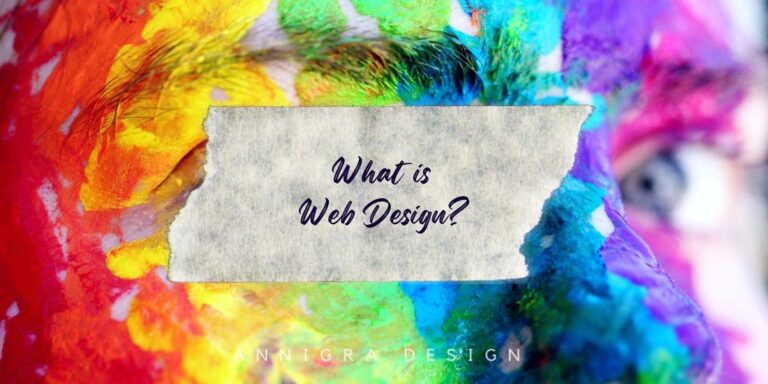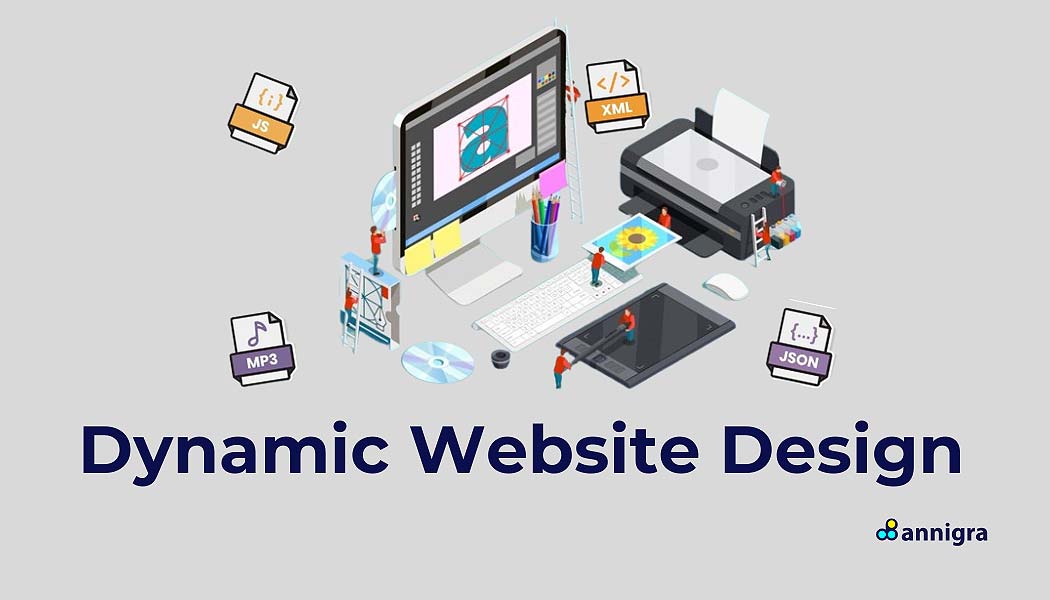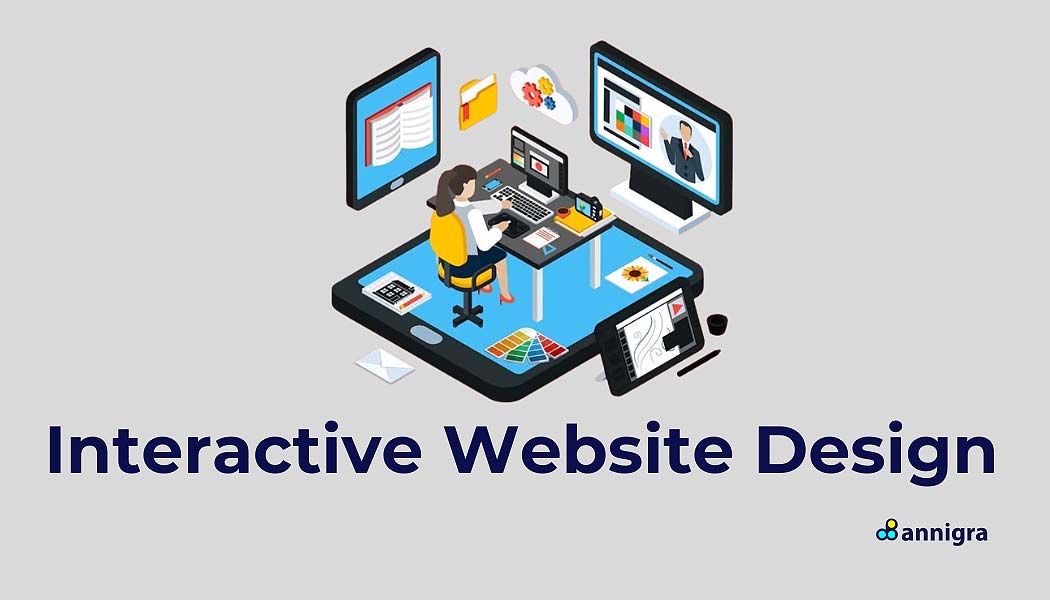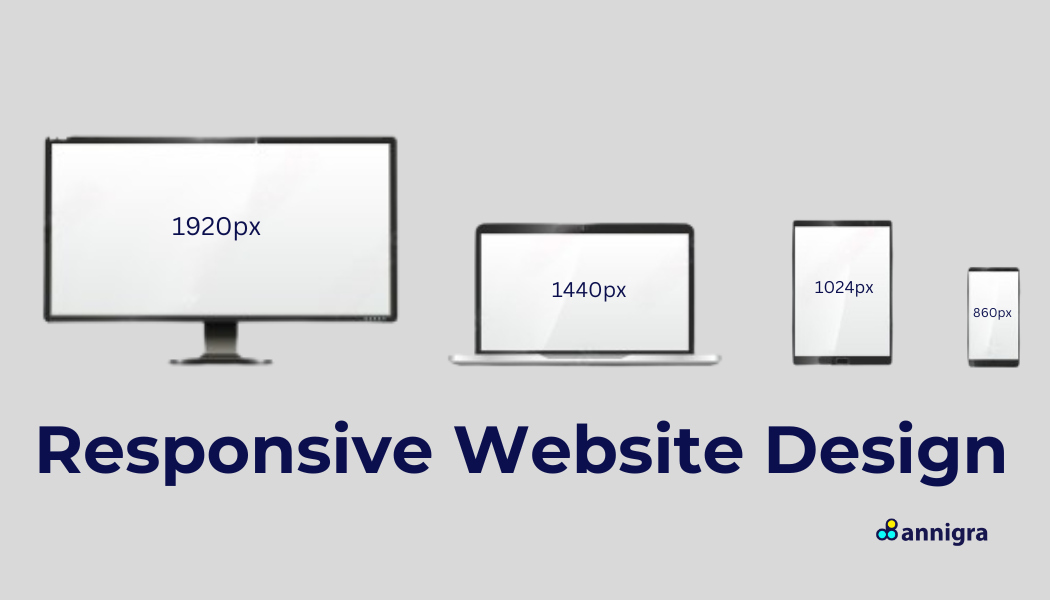Welcome to Annigra Design, your trusted partner for web design expertise in Portland, Oregon. In this article, we will delve into the intriguing world of web design, providing you with an in-depth understanding of this dynamic field. Whether you’re a business owner seeking to enhance your online presence or an aspiring web designer eager to expand your knowledge, we’re here to guide you through the exciting realm of web design.
Table of Contents
ToggleThe Definition of Web Design: Shaping the Digital Experience
Web design is a dynamic field that shapes our online interactions. Web design refers to creating and structuring websites to provide visitors an engaging and user-friendly experience. It is both an art and a science, encompassing various elements and principles that work harmoniously to achieve the desired outcome.
Web design carefully considers visual aesthetics, usability, functionality, and accessibility. It is not merely about creating a visually appealing website but also about ensuring it effectively communicates the intended message, facilitates easy navigation, and adapts seamlessly to different devices and screen sizes.
One of the critical aspects of web design is user-centricity. A well-designed website prioritizes the needs and preferences of its target audience. It focuses on delivering a positive user experience by presenting information clearly, optimizing load times, and ensuring intuitive navigation.
Web designers use various tools and technologies, such as HTML (Hypertext Markup Language), CSS (Cascading Style Sheets), and JavaScript, to create a website’s visual and interactive elements. They also consider color schemes, typography, layout, and multimedia content to craft a cohesive and visually appealing digital environment.
Web design involves a meticulous process that starts with conceptualizing the website’s layout, color scheme, and overall aesthetics. It extends to coding and programming to ensure the website functions seamlessly and is accessible on various devices and browsers.
Elements of Web Design: Building Blocks of Digital Creativity
Web design, a blend of art and technology, relies on fundamental elements that shape websites’ visual and functional aspects. These elements work in harmony to create an engaging online experience for visitors. Let’s explore these key components that form the building blocks of web design.
- Layout: The layout determines the arrangement of content, such as text, images, and navigation menus, on a web page. It aims to create a logical structure for information presentation and intuitive user navigation.
- Color Scheme: Color choices significantly impact a website’s aesthetics and emotional appeal. Designers select color palettes that reflect the brand’s identity and evoke desired emotions in users.
- Typography: Typography involves selecting fonts, font sizes, spacing, and styling to enhance readability and convey the website’s personality.
- Graphics: Visual elements, including images, icons, and multimedia content, enrich the user experience. High-quality graphics not only enhance aesthetics but also convey information effectively.
Combined with user-centric design principles, these elements create a cohesive and visually appealing website. Influential web designers carefully balance these elements to ensure the website looks appealing and functions seamlessly, offering a delightful user experience. Whether you’re a business owner or a web design enthusiast, understanding these elements is crucial for creating an impactful online presence.
Web Designing Platforms
Selecting the right platform for your website is a pivotal decision influencing its functionality and ease of maintenance. Let’s explore some popular web designing platforms:
- WordPress: WordPress is a versatile and widely used content management system (CMS) that powers a significant portion of the internet. It offers a user-friendly interface, a vast library of plugins, and customizable themes, making it suitable for various website types.
- Wix: Wix is a user-friendly website builder for beginners and small businesses. It provides an intuitive drag-and-drop interface and a range of templates for creating visually appealing websites.
- Squarespace: Squarespace is known for its elegant and modern templates, making it a preferred choice for creatives and businesses needing a polished online presence. It offers integrated hosting, e-commerce capabilities, and customizable designs.
Web Designing Tools
Web designers rely on various tools and software applications to bring their creative visions to life. Here are some essential tools commonly used in the web design industry:
- Adobe Creative Cloud: Adobe Creative Cloud is a comprehensive software suite that includes Photoshop, Illustrator, XD (Experience Design), and more. These tools are indispensable for creating stunning visuals, designing graphics, and prototyping web layouts.
- Sketch: Sketch is a popular vector-based design tool specifically tailored for web and app design. It’s known for its ease of use, precision, and a wide range of plugins that extend its functionality.
- Sublime Text: Sublime Text is a versatile text editor favored by web developers for its speed and extensibility. It supports various programming languages and offers features like code highlighting and auto-completion.
- Figma: Figma is a collaborative web-based design tool that allows multiple team members to work on projects in real time. Its cloud-based nature makes it accessible from anywhere, fostering collaboration among designers and stakeholders.
What are the 3 types of web design?
Web design is a multifaceted field, encompassing various approaches and styles to create websites that cater to different needs and objectives. Understanding the three primary types of web design – static, dynamic, and interactive is essential for choosing the right approach for your website.
Static Web Design
Static web design is the most straightforward type, characterized by fixed content that remains unchanged unless manually updated by a web developer. These websites are cost-effective and well-suited for businesses or individuals looking to establish an online presence with minimal content updates. Examples include personal blogs, digital portfolios, and small business websites. Static websites load quickly and are relatively easy to create, making them an excellent choice for those with limited technical expertise.
Dynamic Web Design
Dynamic web design takes a more dynamic approach, incorporating databases and content management systems (CMS) to enable real-time content updates and user interactions. These websites are highly adaptable and suitable for businesses that frequently update their content, such as news websites, e-commerce platforms, and blogs with multiple contributors. CMS platforms like WordPress, Joomla, or Drupal empowers users to add, edit, and manage content without extensive coding knowledge. Dynamic websites provide a more engaging user experience and often feature interactive elements like forms, comments, and user accounts.
Interactive Web Design
Interactive web design represents the most advanced and engaging form of web development. These websites go beyond dynamic design by focusing on real-time user engagement and participation. Interactive websites incorporate features such as live chats, forums, user-generated content, and social media integration. They are ideal for online communities, social networks, and web applications that thrive on user interaction and contributions. Building interactive websites requires more development expertise and often involves custom programming to create the desired features.
What is responsive web design?
Responsive web design is the key to a seamless online experience across all devices, from large desktop monitors to pocket-sized smartphones. It’s the art of creating websites that automatically adjust their layout and content to fit any screen, ensuring user-friendliness and accessibility.
This approach relies on flexible grids, fluid images, and media queries, allowing websites to transition smoothly between different screen sizes. Responsive design enhances user experience, boosts SEO, and simplifies maintenance.
We’ll dive into its principles, techniques, and benefits in exploring responsive web design. Whether you’re a developer aiming to master this skill or a business owner looking to provide a consistent online presence, responsive web design is your key to success in the digital world.
What is adaptive web Design?
In the ever-evolving landscape of web development, adaptive web design emerges as a dynamic approach beyond responsiveness. Adaptive design isn’t merely about fitting content to various screens; it’s about customizing the user experience to specific devices and user preferences. This approach employs a mix of flexible layouts, server-side components, and client-side scripts to ensure that websites adapt intelligently to the capabilities and constraints of each user’s device. This concise exploration of adaptive web design will delve into its principles, techniques, and advantages. Whether you’re a web developer seeking to master this advanced approach or a business owner aiming to provide tailored online experiences, adaptive web design is the path to personalized digital success.
Web Design vs. Website Development
The distinction between web design and website development is akin to the yin and yang of digital craftsmanship when creating and launching websites. While the terms are often used interchangeably, they represent two distinct facets of the web-building process, each vital in bringing an online presence to life.
Web Design
It’s the artistry that graces the digital canvas. Web designers are the creative visionaries who shape a website’s aesthetics, layout, and user interface. They carefully choose color palettes, fonts, images, and overall design elements to create a visually appealing and user-friendly online environment. Web design ensures that a website captures the essence of a brand and offers an engaging user experience.
Website Development
This is the engine that powers the website. Website developers are the architects and builders who take the design’s blueprint and turn it into a functional, interactive, and dynamic web presence. They utilize coding languages like HTML, CSS, JavaScript, and more to create the structural framework, enable functionality, and ensure the website performs flawlessly across various devices and browsers.
Basic markup languages
In the vast and interconnected world of the World Wide Web, the underlying structure of web content relies on markup languages. These fundamental tools serve as the building blocks, allowing web developers to craft and format the text, images, and multimedia that make up websites.
The basic markup languages are at the heart of this digital language. While HTML (Hypertext Markup Language) stands as the cornerstone, CSS (Cascading Style Sheets) and XML (eXtensible Markup Language) play equally crucial roles in shaping the visual and structural elements of web content.
HTML
HTML is the bedrock of web development. It provides the structure for web pages by defining headings, paragraphs, links, and lists. With HTML, content is organized into a hierarchy, ensuring that browsers can interpret and display it correctly. HTML5, the latest version, introduces new features and improvements, allowing multimedia integration and enhanced interactivity.
CSS
CSS complements HTML by controlling the presentation and layout. It allows developers to apply styles, such as fonts, colors, and spacing, to HTML elements. CSS enables the separation of content and design, making creating visually appealing and responsive websites easier.
XML
On the other hand, XML serves as a versatile markup language for structuring and transporting data. It is not limited to web pages but finds applications in various fields, including data exchange, configuration files, and content management.
What is UX in web design?
User Experience (UX) in web design refers to a visitor’s overall experience when interacting with a website or digital product. It encompasses all aspects of the user’s interaction, from their first impression upon arriving at a website to their ability to navigate it easily, find relevant content, and accomplish their goals efficiently.
Key elements of UX in web design include
- Usability: A user-friendly interface is paramount. Designers strive to create intuitive navigation, clear labeling, and easy-to-use forms and buttons. The goal is to minimize friction and make it simple for users to complete tasks.
- Accessibility: Ensuring the website is accessible to all users, including those with disabilities, is essential. This involves providing alternative text for images, using semantic HTML, and adhering to web accessibility guidelines (WCAG).
- Visual Design: Visual aesthetics play a significant role in user experience. Consistent branding, a pleasing color scheme, well-chosen typography, and engaging imagery contribute to a website’s overall appeal.
- Content: Content should be informative, relevant, and well-organized. Users should find what they need quickly, and the content should guide them through the site’s purpose and offerings.
- Performance: A fast-loading website is crucial for a positive user experience. Slow load times can lead to frustration and high bounce rates.
- Feedback and Interactivity: Providing feedback to users, such as confirmation messages after form submissions, enhances their understanding of their actions. Interactive elements like sliders or maps can engage users and make the experience more enjoyable.
- User Research: UX designers often conduct user research, including surveys, user testing, and analysis of user behavior, to inform design decisions and improve the website continually.
UX in web design is not a one-time task but an ongoing refinement and optimization process. It focuses on meeting user needs and expectations to create a website that is efficient, enjoyable, and effective in achieving its intended goals. Ultimately, a positive user experience leads to higher user satisfaction, more extended site engagement, and increased conversion rates, making it a critical aspect of successful web design.
What is UI in web design?
User Interface (UI) in web design refers to the specific elements and visual components that users interact with when using a website or digital application. It encompasses the design of buttons, navigation menus, forms, icons, and all other graphical elements that users see and interact with on the screen.
UI design is crucial in ensuring that the user experience (UX) is visually pleasing and functionally efficient. Here are some critical aspects of UI in web design:
- Layout and Organization: UI designers determine how elements are arranged on a web page to create a logical and intuitive flow. This includes the placement of navigation menus, headers, content sections, and calls to action.
- Visual Elements: UI designers choose the website’s visual style and aesthetics, including color schemes, typography, and iconography. Consistency in design elements helps create a cohesive and recognizable brand identity.
- Interactive Elements: Buttons, forms, sliders, and other interactive components are designed to be user-friendly and easy to understand. UI designers focus on ensuring these elements respond as expected when users interact with them.
- Responsiveness: UI design extends to ensuring that the website’s layout and visual elements adapt seamlessly to different screen sizes and devices, providing a consistent and enjoyable experience.
- Accessibility: UI designers must consider accessibility principles to ensure that all users, including those with disabilities, can navigate and interact with the website effectively. This includes providing keyboard navigation, alt text for images, and proper focus indicators
- Feedback and Animation: UI designers use feedback mechanisms like hover effects, tooltips, and animations to provide users with cues about their actions and the system’s response.
- Prototyping and Testing: UI designers often create interactive prototypes to test the usability and functionality of the interface before final implementation. User testing helps identify potential issues and refinements.
UI design is a critical component of web design, working hand in hand with UX design to create websites and applications that look visually appealing and provide a seamless and enjoyable user experience. A well-executed UI design enhances user engagement, encourages interaction, and ultimately contributes to the success of a digital product or website.
What does a web designer do?
A web designer is responsible for creating websites’ visual elements and layout. They choose colors, fonts, and graphics and design user-friendly interfaces. Web designers work closely with developers, collaborate with clients, and ensure websites look good and function well on different devices. Their role is to make websites visually appealing and easy to navigate.
Is it hard to learn web design?
Learning web design can vary in difficulty depending on your background and resources. Basic web design principles can be learned relatively quickly. Still, mastering the craft, especially responsive design and coding, may take more time and practice. Dedication and updating industry trends are key to becoming a proficient web designer.
How do I start web designing?
Starting a career in web design involves a few key steps:
- Learn the Basics: Begin by learning the fundamentals of web design, including HTML, CSS, and basic design principles. Numerous online courses, tutorials, and books are available for beginners.
- Practice: Apply what you learn by creating simple websites and web pages. Experiment with different designs, layouts, and coding techniques to build your skills.
- Responsive Design: Understand the importance of responsive design to ensure your websites work well on various devices. Learn about media queries and flexible layouts.
- Design Tools: Familiarize yourself with design software like Adobe Photoshop and Illustrator or modern web design tools like Adobe XD, Figma, or Sketch.
- Coding Proficiency: Enhance your coding skills to create interactive and dynamic websites. JavaScript is a valuable language to learn for web interactivity.
- Build a Portfolio: As you gain experience, create a portfolio showcasing your best work. Include diverse projects to demonstrate your skills and style.
- Stay Updated: The web design field evolves rapidly. Follow blogs, forums, and industry news to stay current with the latest design trends, technologies, and best practices.
- Networking: Connect with other web designers, join online communities, and attend industry events to learn from others and build a professional network.
- Freelancing or Employment: Decide if you want to work as a freelancer or seek employment with a web design agency or company. Both paths have their advantages.
- Continuous Learning: Web design is a field that requires ongoing learning and adaptation. Embrace new challenges and continue to refine your skills.
Anyone with dedication and a willingness to learn can start web design. The key is to start small, practice regularly, and gradually take on more complex projects as you build your expertise and confidence.
Sources:
- Tondreau, B. (2018). *Layout Essentials: 100 Design Principles for Using Grids.* Rockport Publishers.
- Morton, J. L. (2019). *Color Matters: Branding and Identity.* Rockport Publishers.
- Bringhurst, R. (2012). *The Elements of Typographic Style: Version 4.0.* Hartley & Marks Publishers.
- Tondreau, B. (2019). *Graphics Essentials for Small Offices: The Basics of Communication Design.* Rockport Publishers.
- Tondreau, B. (2019). *Web Design: 101.* Rockport Publishers.
- Krug, S. (2014). *Don’t Make Me Think, Revisited: A Common Sense Approach to Web Usability.* New Riders.
- McFarland, D. (2021). *WordPress: The Missing Manual.* O’Reilly Media.
- Hockenberry, C. (2020). *The WordPress Anthology.* SitePoint.
- Gracia, A. (2019). *Wix Website Builder 2020: The Ultimate Guide for Beginners and Dummies.* Independently published.
- Davidson, A. (2019). *Squarespace for Dummies.* For Dummies.
- Ojutalayo, M. (2019). *Building Business Websites with Squarespace 7.* Packt Publishing.
- Beck, R. (2021). *Adobe Illustrator CC Classroom in a Book.* Adobe Press.
- McCathran, S., & Williams, C. (2018). *Adobe XD CC Classroom in a Book.* Adobe Press.
- Wood, J. (2020). *Sketch: A Guide for the Digital Age.* A Book Apart.
- Bond, D. (2017). *Sublime Text Power User: A Complete Guide.* David Bond.
- Shaw, B. (2021). *Designing in Figma: A Design Workflow Using Atomic Design Principles.* A Book Apart.







